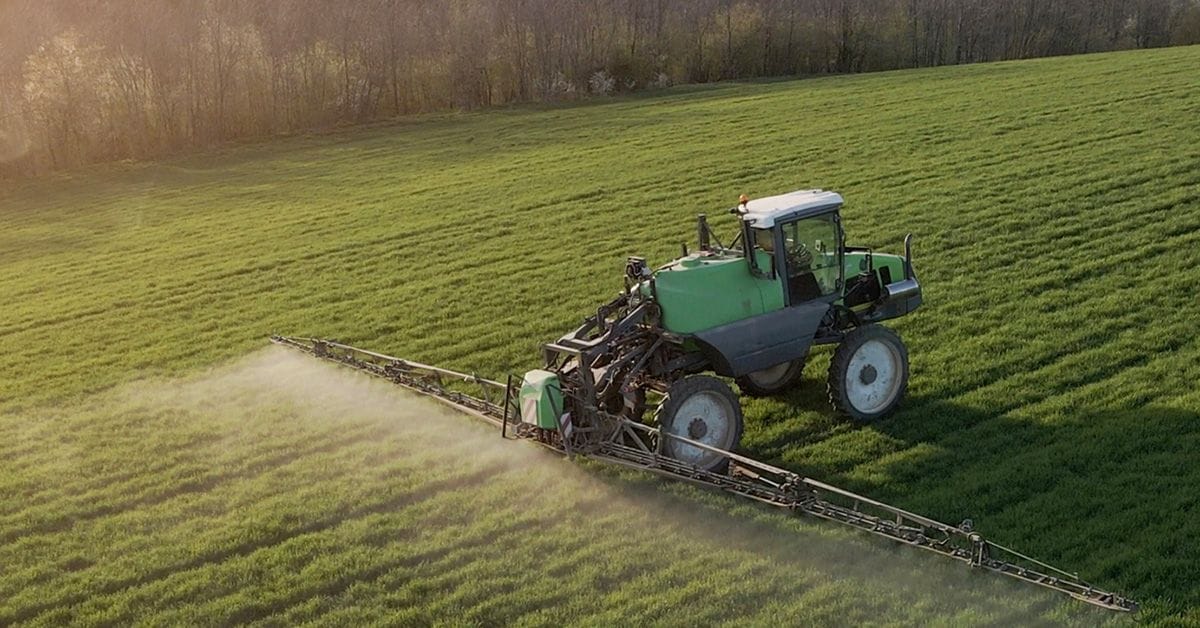Explore how surfactant chemistry improves pesticide performance and reduces environmental loss—and discover the interdisciplinary ACS Publications resources you can use to drive your next breakthrough in sustainable, effective crop protection.

Pesticides play a critical role in safeguarding crop yields, and their use is on the rise. According to the most recent United Nations report1 (2022), global pesticide consumption has doubled since 1990. But their effectiveness is often undermined by environmental loss and associated environmental risks. To make pesticides safer and more efficient, scientists turn to surfactant chemistry.
Surfactants increase the likelihood that pesticides stay where they’re needed and work as intended. When added to pesticide formulations, surfactants improve spreading, wetting, and absorption. These properties increase pesticide efficacy in leaf-applied protection, seed coatings, and soil applications, and they help minimize loss from spray drift, runoff, volatilization, and evaporation.
Research on surfactant behavior on a variety of surfaces informs how scientists enhance pesticide performance, retention, foliar penetration, and rainfastness. In addition to titles like ACS Agricultural Science and Technology and the Journal of Agriculture and Food Chemistry, researchers should look to other publications for high-impact knowledge that can be applied to agricultural research. For example, a recent study of droplet splash dynamics by Varghese et al. published in Langmuir demonstrates the effect of surfactants on droplet impact. Langmuir is a highly cited journal focused on interfaces, which may not make it a journal agricultural researchers read regularly, but this investigation into surfactants has direct implications for spraying both pesticides and fertilizer in agriculture.
As with interface research, agricultural researchers may not pay close attention to nanostructure synthesis, yet it too holds important implications for pesticide use. A study on nanomaterial design by Comer et al. published in ACS Nano demonstrates the reliability of molecular dynamics simulation to predict absorption. Using atrazine, the authors model nanomaterial design that optimizes atrazine absorption and delivery, which could significantly increase the efficacy of this common herbicide.
As agriculture strives to produce more with fewer environmental side effects amid changing environmental conditions, surfactant chemistry and other research areas offer a path forward. By revealing the chemical principles that support innovation, research in journals focused on disciplines outside of agriculture enable breakthroughs in effective and sustainable crop protection.
Empower Your Discoveries with ACS Publications
Learn more about how ACS Publications can help you advance your agricultural and food research or get in touch with a representative if you have questions.
Read More Surfactant Articles in ACS Journals
Enhancing Droplet Spreading on a Hydrophobic Plant Surface by Surfactant/Cellulose Nanocrystal Complexes
Gaili Cao, Weinan Zhao, Lian Han, Youchao Teng, Shikuan Xu, Han Nguyen, and Kam Chiu Tam*
DOI: 10.1021/acsnano.4c13542
Strategy for the Selection of Tank-Mix Adjuvants to Improve the Wetting of Foliar Pesticide Sprays
Dan Liu, Bo Pan, Bingjie Wang, Yong Lin, and Lei Jiang*
DOI: 10.1021/acs.langmuir.4c05121
Effect of Surfactants on the Splashing Dynamics of Drops Impacting Smooth Substrates
Nonu Varghese, Thomas C. Sykes, Miguel A. Quetzeri-Santiago, Alfonso A. Castrejón-Pita, and J. Rafael Castrejón-Pita*
DOI: 10.1021/acs.langmuir.3c03248
Deposition and Spread of Aqueous Pesticide Droplets on Hydrophobic/Superhydrophobic Surfaces by Fast Aggregation of Surfactants
Yaxun Fan and Yilin Wang*
DOI: 10.1021/acs.langmuir.3c00282
Design and Synthesis of a Water-Based Nanodelivery Pesticide System for Improved Efficacy and Safety
Changcheng An, Bingna Huang, Jiajun Jiang, Xinyue Wang, Ningjun Li, Huihui Liu, Yue Shen, Changjiao Sun, Shenshan Zhan, Xingye Li, Chong Wang, Zhanghua Zeng, Haixin Cui, Qingjun Wu, Youjun Zhang, Zhiling Guo, Peng Zhang, Iseult Lynch, Jin-Ming Gao*, and Yan Wang*
DOI: 10.1021/acsnano.3c08854
Antisurfactant (Autophobic) Behavior of Superspreader Surfactant Solutions on Hydrophobic Plant Leaves
Bijoy Bera*, Ellen H. G. Backus, Odile Carrier, Mischa Bonn, Noushine Shahidzadeh, and Daniel Bonn
DOI: 10.1021/acs.langmuir.1c00475
The Use of Folate/Zinc Supramolecular Hydrogels to Increase Droplet Deposition on Chenopodium album L. Leaves
Yuying Song, Chong Cao*, Kaerdun Liu, Jianbin Huang, Li Zheng, Lidong Cao, Fengmin Li, Pengyue Zhao, and Qiliang Huang*
DOI: 10.1021/acssuschemeng.0c03396
Simple, Effective, and Ecofriendly Strategy to Inhibit Droplet Bouncing on Hydrophobic Weed Leaves
Yue Ma, Yuxia Gao, Kefei Zhao, Hao Zhang, Zilu Li, Fengpei Du*, and Jun Hu*
DOI: 10.1021/acsami.0c13066
Impact Behaviors on Superhydrophobic Surfaces for Water Droplets of Asymmetric Double-Chain Quaternary Ammonium Surfactants
Haofei Li, Zhuojun Cai, and Yilin Wang*
DOI: 10.1021/acs.langmuir.0c02783
Enhancing Droplet Deposition on Wired and Curved Superhydrophobic Leaves
Meirong Song*, Duan Hu, Xianfu Zheng, Lixia Wang, Zhilun Yu, Wankai An, Risong Na, Chuxin Li, Ning Li, Zhouhui Lu, Zhichao Dong*, Yilin Wang*, and Lei Jiang
DOI: 10.1021/acsnano.9b02457
Topology-Regulated Pesticide Retention on Plant Leaves through Concave Janus Carriers
Kefei Zhao, Jun Hu, Yue Ma, Tianyue Wu, Yuxia Gao*, and Fengpei Du*
DOI: 10.1021/acssuschemeng.9b02319
Controlling Pesticide Loss through Nanonetworks
Yubin Xiang, Min Wang, Xiao Sun, Dongqing Cai*, and Zhengyan Wu*
DOI: 10.1021/sc400513p
References
- Food and Agriculture Organization of the United Nations (FAO). Pesticides Use and Trade – 1990–2022; FAOSTAT Analytical Briefs No. 89; Food and Agriculture Organization of the United Nations: Rome, 2024. https://doi.org/10.4060/cd1486en (accessed 2025-04-28).
- Andersen, Ely. Evaluation of Salt-Based Adjuvants on Weed Control with Glufosinate and Glyphosate Herbicide Tank-Mixtures; M.S. Thesis, University of Nebraska–Lincoln, 2021. https://digitalcommons.unl.edu/agronhortdiss/228